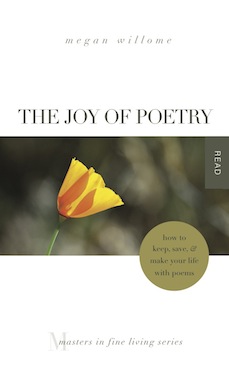I had that talk with my publisher (the one I wrote about last week) around the start of Lent 2015. As I sat in the Ash Wednesday service, surrounded by school children fidgeting in their dress uniforms, the thought came to me: Write as little as possible.
I decided to take the season to think about, imagine, and sit with the idea of writing about my mom and her cancer as a way to frame and tie together a spirited defense of poetry. When an idea or a memory came to me, I wrote it out. Then I’d close my notebook and move on.
Along the way I began making lists. One was of all the poems I’d gotten permissions for. I starred my favorites. Then I made a list of all the poems I’d written about my mom, and I starred the ones other people told me they liked. I looked at both lists for a while. Did any of those poems go together? Were there any common themes? (That’s when I discovered a connection with the color yellow.)
I started thinking about the word “joy, ” since it was supposed to be the theme of the book. What joys lurked in these memories of my mom? Could I organize each chapter around a specific joy? And what did joy have to do with a book that was shaping up to be about cancer, poetry, and death?
During that time I read only two books, and I did that on purpose. I wanted to focus on writing that accomplished what I aspired to. One was L.L. Barkat’s Rumors of Water. I’d already read it, but this time I read it for structure, taking notes on how it worked. I got the idea for how to title my chapters by noticing how she titled hers. If you’ve only read this book once, please read it again. It’s quite brilliant.
The other book was Helen McDonald’s H Is for Hawk, which is part grief memoir after losing her dad, part analysis of author T.H. White’s life and work, and part how to train a goshawk. It’s three seemingly disconnected strands that she weaves into a braid. In my book, I was using two — Mom and poetry. That’s only a twist.
When Easter came, I started to rewrite. The task of gathering all my notes — spread across journals, on my computer, and on random scraps of paper — took a couple of days and made a mess on my picnic table that serves as a desk. I gathered everything into a yellow Manila folder, since I’d decided yellow was going to be A Thing.
While I was rewriting, I dedicated a sheet of notebook paper to each chapter. Each sheet started with the title — a quote from one of the poems in that chapter — then a colon, then a summary of that chapter’s theme. Next I wrote the word “joy” followed by any sentences in the chapter that featured the word. (I literally put “joy” into the search field to check.) Then I wrote the word “cancer, ” followed by whatever sentences about cancer or Mom were in the chapter. Then halfway down the page I wrote the word “poetry” and listed the poems I wanted to feature in that particular chapter, both mine and others’. On the back of each piece of paper I wrote a list of stories and vignettes featured in the chapter. For instance, for chapter 1, one of those items on the list says “Frederick, ” reminding me the mouse belongs there. I wrote everything in pencil. The chapter numbers were erased multiple times as I rearranged the pages by hand.
Why did I do it that way? It made sense to me.
I approached rewriting differently than I had the first round of writing. I wrote with pauses. Each time I sat down, I worked for 1 hour and 5 minutes. When my dinger went off, if I had time and inclination to write more, I would. The most I ever wrote at one stretch was 3 hours, 15 minutes. If I needed to get on with my work for the magazine or editing or life, I did. Usually I worked on the book early in the day, but not always. I followed this routine six days a week, except for Saturdays, which I took off.
The white space in between writing allowed time for my brain to play, to make connections, or simply to rest. I once read a quote that jazz is all about the pauses. Maybe writing is too.
I gave myself a deadline to finish the rewrite — Ascension Day. I chose the day for the obvious reason that my document would ascend as I uploaded it into cyberspace to my publisher’s preferred platform. Also because it was a week before my daughter would come home from school, and I wanted a few days to pause greatly before summer’s busyness started.
But before I ascended my manuscript, I needed to talk to my dad.
Photo by Pai Shih, Creative Commons, via Flickr. Post by Megan Willome, author of The Joy of Poetry.
Read On Being Asked: Creating The Joy of Poetry – Part 1
Read What to Do with the Elephants: Creating The Joy of Poetry – Part 2
__________
“Megan Willome’s The Joy of Poetry is not a long book, but it took me longer to read than I expected, because I kept stopping to savor poems and passages, to make note of books mentioned, and to compare Willome’s journey into poetry to my own. The book is many things. An unpretentious, funny, and poignant memoir. A defense of poetry, a response to literature that has touched her life, and a manual on how to write poetry. It’s also the story of a daughter who loses her mother to cancer. The author links these things into a narrative much like that of a novel. I loved this book. As soon as I finished, I began reading it again.”
—David Lee Garrison, author of Playing Bach in the D. C. Metro
- Perspective: The Two, The Only: Calvin and Hobbes - December 16, 2022
- Children’s Book Club: A Very Haunted Christmas - December 9, 2022
- By Heart: ‘The night is darkening round me’ by Emily Brontë - December 2, 2022


Bethany R. says
“Write as little as possible.”
Thanks for this piece, it’s fascinating to hear how your process came together. I like the idea of writing for about an hour, and as memories or ideas come. You still had plenty of structure to organize your thoughts with, but you found a doable way to write on topics that could be quite complicated to sift through.
Megan Willome says
Thanks, Bethany!
The idea to write as little as possible was anathema to me. It seemed like the opposite of what I was supposed to be doing. But like you said, it gave me some structure while freeing me up at the same time.
Matthew Kreider says
To me, the daily “how” of poetry becoming a loved one in your life was so enchanting and so inviting. Today’s behind-the-scenes look at the making of your book is just another confirmation of how gratifying it is to watch process turn to joy. And to a really wonderful book.
And I smiled when I clicked on your “jazz” link. I’m honoured to have a link with you, Megan.
Because a link is what your book offered me. 🙂
Matthew Kreider says
(Full disclosure: I find it quite gratifying to know each word was written in pencil, too.) 🙂
Megan Willome says
Matthew, the case could be made that poetry is all about the links.
Thanks for your kind words. And for being a fellow pencil enthusiast.
Laura Brown says
I love the information about process here. And the significance of the liturgical calendar for you.
I regret that I am not able to leave this comment in pencil.
Megan Willome says
I regret it, too, Laura.
And who cares that it’s October 10, Columbus Day? It’s Monday of the 28th Week in Ordinary Time.
Donna Falcone says
These words grabbed me: The white space in between writing….
Was it hard for you to create that white space for yourself?
I’m not good at creating my own white space…. I become too frantic, and that is no good for anyone or any project.
Thank you for sharing your process, Megan. It’s wonderful to read about how you created this book and the shift… how you navigated the shift. Beautiful.
Megan Willome says
Donna, yes, creating the white space was hard. It’s not in my nature. I’m a hard worker by nature. But because I was only committing to it for a specific length of time, it was easier. Then it worked so well that I’ve been more intentional about white space since. Some seasons it’s harder to maintain than others.
Diana Trautwein says
Thank you for this series, Megan. For the priceless peeks into your own process — fascinating and helpful.
Megan Willome says
Thank you, Diana!